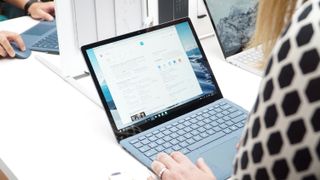In defence of the Microsoft Surface laptop
Microsoft has no choice but to pitch the device at a high price

Microsoft launched the Surface Laptop yesterday, and while everybody seems to agree on how great a piece of hardware engineering it is, analysts and journalists have been quick to point out to what seems like major flaws in Microsoft’s launch strategy: the pricing - $999 for the cheapest model - and the locked-down-but-still-upgradable Windows 10 S.
While that might look like folly to the outside world, it would make sense to those who have been following Microsoft for long enough to have witnessed the various attempts by the company to create different Windows versions targeting niche segments outside the B2B market. So let’s see why Microsoft might have opted for those two controversial decisions.
The pricing
Microsoft’s Windows underpins an entire ecosystem consisting of resellers, independent software vendors, retailers, developers, manufacturers and so on. Any product launches need to bear that in mind in order to cause minimal disruption.
The company took a page from Google’s book, pitching the Surface Laptop at a relatively high price to voluntarily restrict the demand for the device and deliver a blueprint for others to copy and emulate.
Its impact on the market has been critical as partners of all sizes rode on Microsoft’s mighty marketing clout to deliver products that fitted into the mould, allowing them to lift their average selling prices and enjoy higher margins.
The Surface has created a halo effect that trickles down to all parts of the ecosystem, the same way the Pixel, and before that the Nexus, did for Google. Microsoft is probably making a bit of money on Surface as a line of business; its third quarter earning figures show that the revenues fell by more than a quarter to $831 million.
So you can be pretty sure that manufacturers and OEMs (Original Equipment Manufacturers) are getting ready to pump out a number of devices that fit comfortably in the market the Surface laptop will have created. And expect them to appear en masse at Computex in Taipei in June 2017.
Are you a pro? Subscribe to our newsletter
Sign up to the TechRadar Pro newsletter to get all the top news, opinion, features and guidance your business needs to succeed!
Windows 10 S
That iteration brought back memories of Windows RT and to a lesser extent, the various Windows Starter editions that existed before. Windows 10 S, however, is different. For a start it doesn’t target the entry level market and is not shoehorned in devices that have slow processors or low system memory (although some might argue that a $999 laptop with 4GB, like the Surface Laptop, is outright daylight robbery).
It is also streamlined for security and performance, running great on old software and faster on new ones. The tighter filtering Microsoft has on legacy apps means that Windows 10 code is likely to be cleaner and lighter. The knock-on effects includes improved security, improved battery life and surprise, surprise, a bucketful of Pro features plus a one-year subscription to Office 365 Personal.
Windows 10 S does maintain compatibility with legacy apps (albeit in a limited way) and if you are still not happy, you can always upgrade to Windows 10 Pro (not Home) for free till the end of the year. From Microsoft’s perspective, it is essentially emulating Google - with Chrome OS and Android - and Apple - with iOS and MacOS. Both competitors have tight control over what can be installed and where it comes from.
The big problem, though, remains the sheer desolation of Microsoft’s Store (it is telling that the best selling app is a 2-star application from Microsoft called Windows DVD player).
But by pitching it squarely at the education market - where software installations are tightly controlled and limited anyway - Microsoft wants to educate a new generation while solving the tricky chicken-and-egg problem of how to build a significant user base to attract developers.
All the pieces of the puzzle are in place for Windows 10 S to become a sizzling success rather than a stupid smorgasbord and the stepping stone for the next phase; Windows as a Service.
- Is it time for a Surface Pro 5? We certainly hope so

Désiré has been musing and writing about technology during a career spanning four decades. He dabbled in website builders and web hosting when DHTML and frames were in vogue and started narrating about the impact of technology on society just before the start of the Y2K hysteria at the turn of the last millennium.
Most Popular




